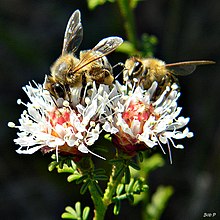Dalbergioids

| Dalbergioids | |
|---|---|
 | |
| Dalea pinnata flowers being visited by bees | |
| Scientific classification | |
| Kingdom: | Plantae |
| Clade: | Tracheophytes |
| Clade: | Angiosperms |
| Clade: | Eudicots |
| Clade: | Rosids |
| Order: | Fabales |
| Family: | Fabaceae |
| Subfamily: | Faboideae |
| Clade: | Meso-Papilionoideae |
| Clade: | Dalbergioids (M. F. Wojciechowski, M. Lavin, and M. J. Sanderson 2004)[1] M. F. Wojciechowski 2013[2][3][4] |
| Tribes | |
| Synonyms | |
| |
The dalbergioids are an early-branching monophyletic clade of the flowering plant subfamily Faboideae or Papilionaceae. They are pantropical, particularly being found in the neotropics and sub-Saharan Africa.[5] This clade is consistently resolved as monophyletic in molecular phylogenetic analyses.[2][3][4][6][7][8][9][10][11][12][13] It is estimated to have arisen 55.3 ± 0.5 million years ago (in the Eocene).[9] A node-based definition for the dalbergioids is: "The least inclusive crown clade that contains Amorpha fruticosa L. 1753 and Dalbergia sissoo Roxb. ex DC. 1825."[2] Indehiscent pods may be a morphological synapomorphy for the clade.[4]
References
[edit]- ^ Wojciechowski MF, Lavin M, Sanderson MJ (2004). "A phylogeny of legumes (Leguminosae) based on analysis of the plastid matK gene resolves many well-supported subclades within the family". Am J Bot. 91 (11): 1846–862. doi:10.3732/ajb.91.11.1846. PMID 21652332.
- ^ a b c Wojciechowski MF. (2013). "Towards a new classification of Leguminosae: Naming clades using non-Linnaean phylogenetic nomenclature". S Afr J Bot. 89: 85–93. doi:10.1016/j.sajb.2013.06.017.
- ^ a b Cardoso D, de Queiroz LP, Pennington RT, de Lima HC, Fonty É, Wojciechowski MF, Lavin M (2012). "Revisiting the phylogeny of papilionoid legumes: new insights from comprehensively sampled early-branching lineages". Am J Bot. 99 (12): 1991–2013. doi:10.3732/ajb.1200380. PMID 23221500.
- ^ a b c Cardoso D, Pennington RT, de Queiroz LP, Boatwright JS, Van Wyk BE, Wojciechowski MF, Lavin M (2013). "Reconstructing the deep-branching relationships of the papilionoid legumes". S Afr J Bot. 89: 58–75. doi:10.1016/j.sajb.2013.05.001. hdl:10566/3193.
- ^ Klitgaard BB, Lavin M (2005). "Tribe Dalbergieae sens. lat". In Lewis G, Schrire B, Mackinder B, Lock M (eds.). Legumes of the World. Royal Botanic Gardens, Kew. pp. 307–335. ISBN 978-1900347808.
- ^ McMahon M, Hufford L (2004). "Phylogeny of Amorpheae (Fabaceae: Papilionoideae)". Am J Bot. 91 (8): 1219–1230. doi:10.3732/ajb.91.8.1219. PMID 21653479.
- ^ Lavin M, Pennington RT, Klitgaard BB, Sprent JI, de Lima HC, Gasson PE (2001). "The dalbergioid legumes (Fabaceae): delimitation of a pantropical monophyletic clade". Am J Bot. 88 (3): 503–33. doi:10.2307/2657116. JSTOR 2657116. PMID 11250829.
- ^ LPWG [Legume Phylogeny Working Group] (2013). "Legume phylogeny and classification in the 21st century: progress, prospects and lessons for other species-rich clades" (PDF). Taxon. 62 (2): 217–248. doi:10.12705/622.8. hdl:10566/3455.
- ^ a b Lavin M, Herendeen PS, Wojciechowski MF (2005). "Evolutionary rates analysis of Leguminosae implicates a rapid diversification of lineages during the tertiary". Syst Biol. 54 (4): 575–94. doi:10.1080/10635150590947131. PMID 16085576.
- ^ McMahon MM, Sanderson MJ (2006). "Phylogenetic supermatrix analysis of GenBank sequences from 2228 papilionoid legumes". Syst Biol. 99 (12): 1991–2013. doi:10.1080/10635150600999150. PMID 17060202.
- ^ Pennington RT, Lavin M, Ireland H, Klitgaard B, Preston J, Hu JM (2001). "Phylogenetic relationships of basal papilionoid legumes based upon sequences of the chloroplast trnL intron". Syst Bot. 55 (5): 818–836. doi:10.1043/0363-6445-26.3.537 (inactive 1 November 2024).
{{cite journal}}: CS1 maint: DOI inactive as of November 2024 (link) - ^ Doyle JJ, Doyle JL, Ballenger JA, Dickson EE, Kajita T, Ohashi H (1997). "A phylogeny of the chloroplast gene rbcL in the Leguminosae: taxonomic correlations and insights into the evolution of nodulation". Am J Bot. 84 (4): 541–554. doi:10.2307/2446030. JSTOR 2446030. PMID 21708606.
- ^ Hu JM, Lavin M, Wojciechowski MF, Sanderson MJ (2000). "Phylogenetic systematics of the tribe Millettieae (Leguminosae) based on chloroplast trnK/matK sequences and its implications for evolutionary patterns in Papilionoideae". Am J Bot. 87 (3): 418–30. doi:10.2307/2656638. JSTOR 2656638. PMID 10719003.